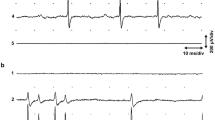Summary
Action potentials of the subumbrellar myoepithelium in the diphyid siphonophoreChelophyes change in form with repetitive stimulation, at first showing an increasing hump or plateau on the falling phase, and finally becoming prolonged events with a large overshoot. Simultaneous records of tension developed by the subumbrellar sheet show that this change is accompanied by increase in tension. Similar prolonged action potentials to those evoked by repetitive stimulation are seen from the outset after application of Ca++-blocking agents such as Co++; maximal tensions are then developed from the first stimulus. The mechanism whereby change in action potential form is linked to increased tension is discussed.
Similar content being viewed by others
References
Chain BM, Bone Q, Anderson PAV (1981) An electrophysiological study of a myoid epithelium inChelophyes (Coelenterata: Siphonophora) J Comp Physiol 143:329–338
Author information
Authors and Affiliations
Additional information
I am indebted to the Director and staff of the Station Zoologique, Villefranche-sur-mer for their hospitality; in particular to Dr. Danielle Carré who allowed me to see the manuscript of Mackie and Carré and to Dr. C. Sardet who loaned the oscilloscope and stimulator. The Browne fund of the Royal Society kindly provided a travel grant.
Rights and permissions
About this article
Cite this article
Bone, Q. The relation between the form of the action potential and contractions in the subumbrellar myoepithelium ofChelophyes (Coelenterata: Siphonophora). J. Comp. Physiol. 144, 555–558 (1981). https://doi.org/10.1007/BF01326840
Accepted:
Issue Date:
DOI: https://doi.org/10.1007/BF01326840




